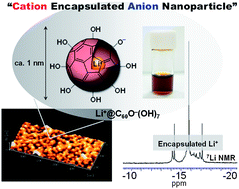Synthesis of a new class of fullerene derivative Li+@C60O−(OH)7 as a “cation-encapsulated anion nanoparticle”†
Abstract
Metal encapsulation into a cage and chemical modification on the outer surface of

* Corresponding authors
a
Division of Applied Chemistry, Graduate School of Engineering, Osaka University, 2-1 Yamadaoka, Suita, Osaka 565-0871, Japan
E-mail:
kokubo@chem.eng.osaka-u.ac.jp
Fax: +81-6-6879-4593
Tel: +81-6-6879-4592
b A Research and Analytical Center for Giant Molecules, Graduate School of Science, Tohoku University, 6-3 Aza-aoba, Aramaki, Aoba-ku, Sendai, Miyagi 980-8578, Japan
Metal encapsulation into a cage and chemical modification on the outer surface of

 Please wait while we load your content...
Something went wrong. Try again?
Please wait while we load your content...
Something went wrong. Try again?
H. Ueno, K. Kokubo, E. Kwon, Y. Nakamura, N. Ikuma and T. Oshima, Nanoscale, 2013, 5, 2317 DOI: 10.1039/C3NR33608E
To request permission to reproduce material from this article, please go to the Copyright Clearance Center request page.
If you are an author contributing to an RSC publication, you do not need to request permission provided correct acknowledgement is given.
If you are the author of this article, you do not need to request permission to reproduce figures and diagrams provided correct acknowledgement is given. If you want to reproduce the whole article in a third-party publication (excluding your thesis/dissertation for which permission is not required) please go to the Copyright Clearance Center request page.
Read more about how to correctly acknowledge RSC content.
 Fetching data from CrossRef.
Fetching data from CrossRef.
This may take some time to load.
Loading related content
